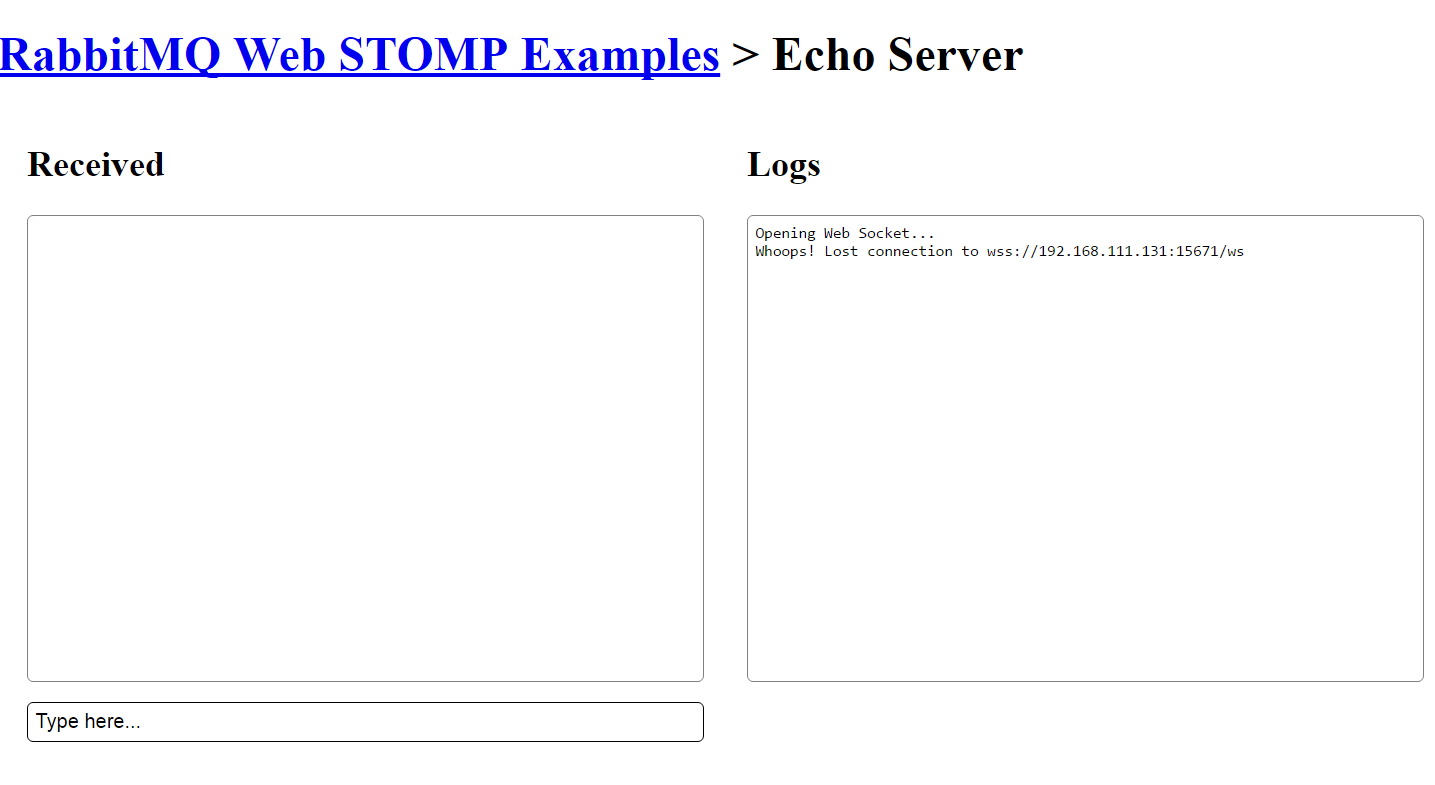
Reputation: 2091
SSL configuration issue with RabbitMQ Web-Stomp Plugin
Firstly, I followed this to generate keys, certificates and CA certificates to directories which are client, server and testca. Then I verified, SSL works. Then I followed this to configure RabbitMQ Web-Stomp Plugin, and my ssl_config is as following:
[
{rabbitmq_web_stomp,
[{ssl_config, [{port, 15671},
{backlog, 1024},
{certfile, "path/to/certs/client/cert.pem"},
{keyfile, "path/to/certs/client/key.pem"},
{cacertfile, "path/to/certs/testca/cacert.pem"},
{password, "changeme"}]}]}
].
However, when I tried to connect it via websockets by following code, which is copied from here, and I made some modifications.
<!DOCTYPE html>
<html><head>
<script src="jquery.min.js"></script>
<script src="stomp.js"></script>
<style>
.box {
width: 440px;
float: left;
margin: 0 20px 0 20px;
}
.box div, .box input {
border: 1px solid;
-moz-border-radius: 4px;
border-radius: 4px;
width: 100%;
padding: 5px;
margin: 3px 0 10px 0;
}
.box div {
border-color: grey;
height: 300px;
overflow: auto;
}
div code {
display: block;
}
#first div code {
-moz-border-radius: 2px;
border-radius: 2px;
border: 1px solid #eee;
margin-bottom: 5px;
}
#second div {
font-size: 0.8em;
}
</style>
<title>RabbitMQ Web STOMP Examples : Echo Server</title>
<link href="main.css" rel="stylesheet" type="text/css"/>
</head><body lang="en">
<h1><a href="index.html">RabbitMQ Web STOMP Examples</a> > Echo Server</h1>
<div id="first" class="box">
<h2>Received</h2>
<div></div>
<form><input autocomplete="off" value="Type here..."></input></form>
</div>
<div id="second" class="box">
<h2>Logs</h2>
<div></div>
</div>
<script>
var has_had_focus = false;
var pipe = function(el_name, send) {
var div = $(el_name + ' div');
var inp = $(el_name + ' input');
var form = $(el_name + ' form');
var print = function(m, p) {
p = (p === undefined) ? '' : JSON.stringify(p);
div.append($("<code>").text(m + ' ' + p));
div.scrollTop(div.scrollTop() + 10000);
};
if (send) {
form.submit(function() {
send(inp.val());
inp.val('');
return false;
});
}
return print;
};
// Stomp.js boilerplate
var client = Stomp.client('wss://192.168.111.131:15671/ws');
client.debug = pipe('#second');
var print_first = pipe('#first', function(data) {
client.send('/queue/webstomp', {"content-type":"text/plain"}, data);
});
var on_connect = function(x) {
id = client.subscribe("/queue/webstomp", function(d) {
print_first(d.body);
});
};
var on_error = function() {
console.log('error');
};
client.connect('test', 'test', on_connect, on_error, '/');
$('#first input').focus(function() {
if (!has_had_focus) {
has_had_focus = true;
$(this).val("");
}
});
</script>
</body></html>
it replied me that I lost connection as following screenshot.

I'd be really appreciate any helpful suggestion on this issue.
BTW: this code example works when I didn't use SSL.
Upvotes: 3
Views: 4102
Answers (2)
Reputation: 11
Update RabbitMQ version 4.0 and Erlang OTP 27.
- You can't install self certificate (I build RabbitMQ Server in VM)
- If your certificate created by manually, you must install certificate in your client
Before use wss://192.168.111.131:15671/ws, You can testing websocket https://192.168.111.131:15671/ws
Upvotes: 0

Reputation: 2091
Finally I figured this out by referring this post, so the key point is to explicitly authorized my certificate by visiting the address in https first, in my case is wss://192.168.111.131:15671/ws. So I need to visit https://192.168.111.131:15671/ws in browser and authorize the exception and then I can make my wss connection normally.
Upvotes: 4
Related Questions
- Cannot established ssl connection with rabbitmq
- RabbitMQ Web Stomp -- Turn off non-TLS connections?
- SSL configurations in Rabbitmq.conf file is not being applied to my rabbitmq-server
- How to use SSL with AppDynamics RabbitMQ Monitoring Plugin
- Spring boot connection failure with RabbitMQ Web STOMP Plugin
- RabbitMQ: handshake error when attempting to use SSL certificates
- Handshake timeout ERROR with ssl connection in RabbitMQ
- SSL enabling for rabbitmq mangement. Server starts, but fails to accept requests
- Stomp.js secure conneciton || Rabbitmq javascript client secure connection
- Can't connect to RabbitMq-c using SSL support